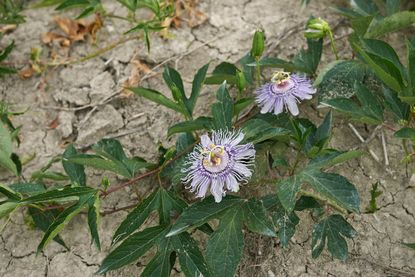Maypop Vine Care – Learn How To Grow Maypops In The Garden


If you are thinking of growing maypop passion vines in your backyard, you’ll want a little more information about these plants. Read on for tips on how to grow maypops and information on maypop vine care.
What are Maypops?
“Maypops” is a short-cut term that is used to refer to maypop passion vines (Passiflora incarnata), rapid growing, tendril climbing vines, sometimes to the point of becoming weedy. Natives of the southeastern United States, these vines produce large, showy flowers followed by the maypop fruits.
Maypop passion vines are attractive vines that can grow up to 25 feet (8 m.). They are best known for their unique, showy flowers that are followed by unusual fruit. The vine’s bark is smooth and green. These vines are woody in warmer climates but die to the ground every year in colder climates.
The maypop flowers are different from any others you might see. They have deeply fringed white flowers, topped with a crown of pale lavender filaments. The fruits that follow the flowers are also called maypops. What are maypops like? They are the size and shape of an egg, appearing on the plant in summer and ripening in fall. You can eat them or make jam and jelly.
How to Grow Maypops
If you are thinking of growing maypops, you’ll be pleased to hear that this native vine doesn’t need tending with kid gloves. If you live in USDA plant hardiness zones 5 through 9, it should be a snap.
Maypop vine care is easy if you grow it in well-drained soil in a site that gets some sun. Full sun is fine, but part sun will also work well. The soil can be average since the plant is not demanding.
Once your vine is established, you won’t have much maypop passionflower care to worry about. The vine needs some irrigation in dry weather, but it is also tolerant of drought.
Gardening tips, videos, info and more delivered right to your inbox!
Sign up for the Gardening Know How newsletter today and receive a free download of our most popular eBook "How to Grow Delicious Tomatoes."
Keep the moisture in the soil and the roots cool by spreading a loose mulch over the soil. In good conditions, the plants spread and thrive. Providing a trellis or similar structure for the vine to climb will help keep the plant from sprawling all over.

Teo Spengler has been gardening for 30 years. She is a docent at the San Francisco Botanical Garden. Her passion is trees, 250 of which she has planted on her land in France.
-
 Urban Composting Guide: How To Compost In The Middle Of The City
Urban Composting Guide: How To Compost In The Middle Of The CityUrban composting does not have to be daunting. You can compost in the city, and maybe even try some urban worm composting!
By Mary Ellen Ellis
-
 Shrub Diseases And Pests To Watch Out For
Shrub Diseases And Pests To Watch Out ForShrub diseases and pests can be challenging. Learn how to recognize and eradicate them before they can present a danger to your plants.
By Susan Albert